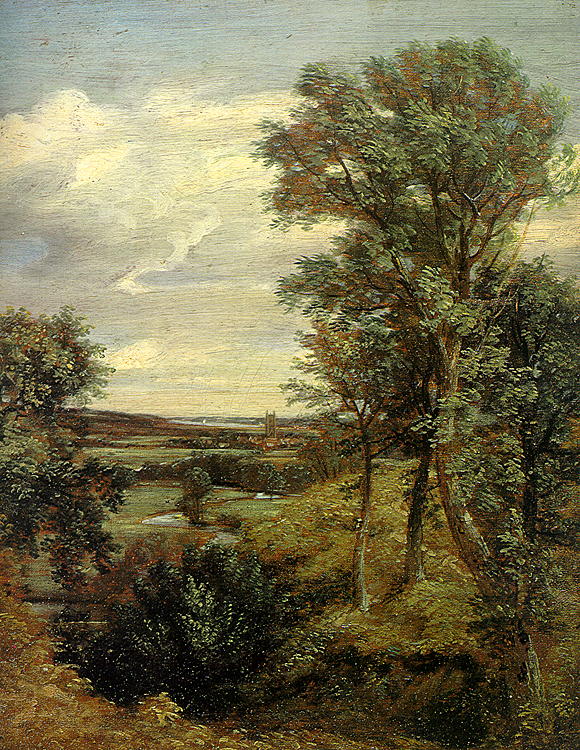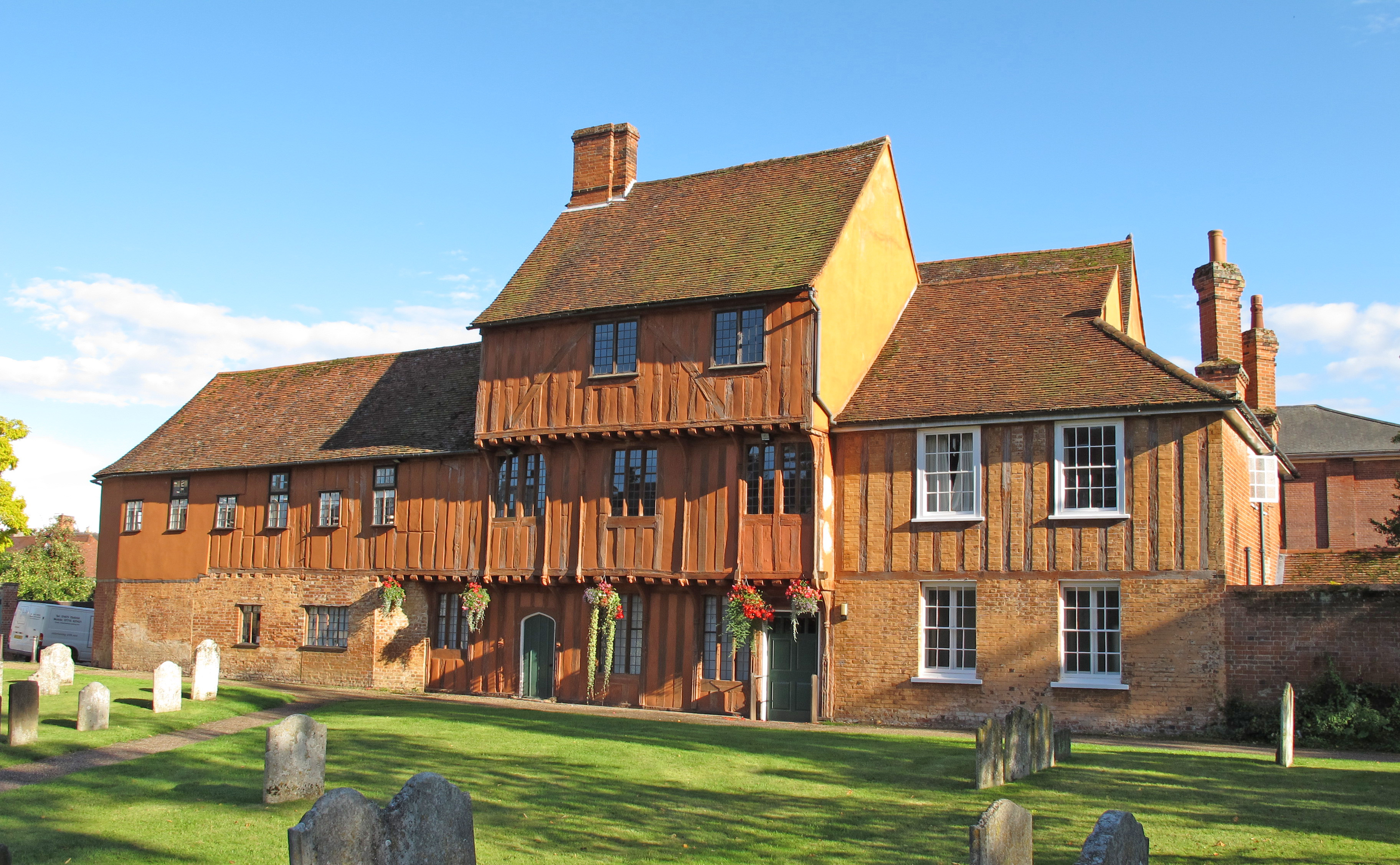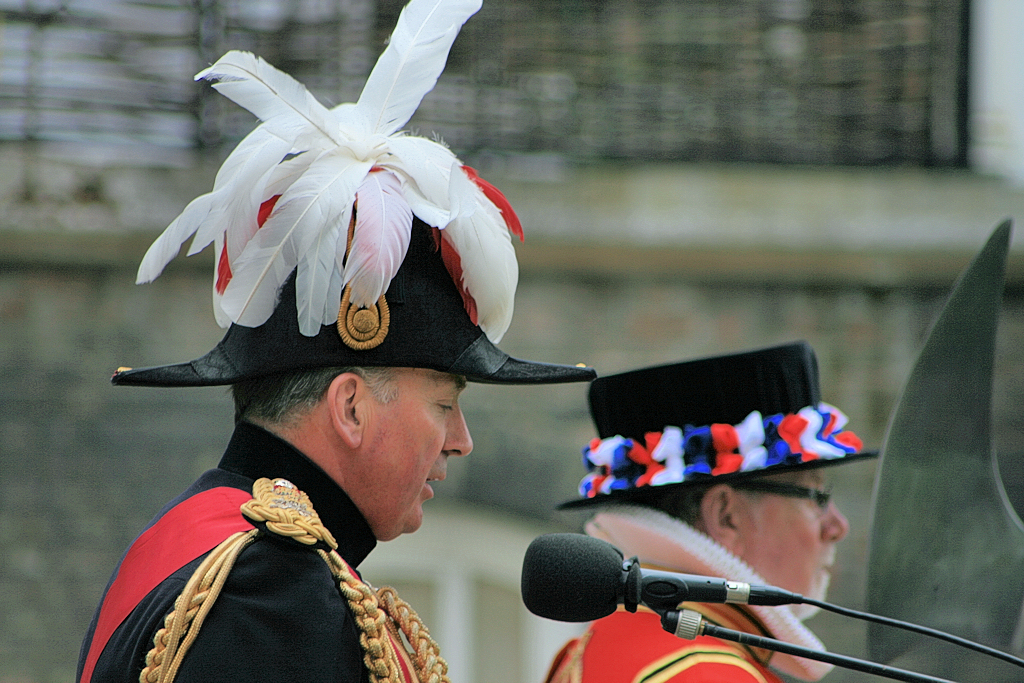|
Dedham, Essex
Dedham is a village in the City of Colchester district of Essex, England. It is near the River Stour, which is the border of Essex and Suffolk. The nearest town to Dedham is the small market town of Manningtree. Governance Dedham is part of the electoral ward called Dedham and Langham. The population of this ward at the 2011 Census was 2,943. Geography Dedham is frequently rated as containing some of England's most beautiful Lowland landscape, most particularly the water meadows of the River Stour, which passes along the northern boundary of the village forming the boundary between Essex and Suffolk. Dedham has a central nuclear settlement around the Church and the junction of Mill Lane and the High Street (part of the B1029). Connected to Dedham are the hamlets of The Heath and Lamb Corner. The village forms a key part of the Dedham Vale. History Early documents record the name as Diddsham, presumably for a family known as Did or Didd. For centuries, the parish of Dedh ... [...More Info...] [...Related Items...] OR: [Wikipedia] [Google] [Baidu] |
City Of Colchester
The City of Colchester is a local government district with city status in Essex, England, named after its main settlement, Colchester. It is, with 194,394 people according to Office of National Statistics estimate for mid 2022, the most populous district in Essex and also includes the towns of West Mersea and Wivenhoe and the surrounding rural areas stretching from Dedham Vale on the Suffolk border in the north to Mersea Island in the Colne Estuary in the south. The district borders Tendring District to the east, Maldon District to the south, Braintree District to the west, and Babergh District in Suffolk to the north. History Colchester was an ancient borough with urban forms of local government from Saxon times. Burgesses were already established by the time of the Domesday survey of 1086. The earliest known borough charter dates from 1189, but that charter appears to confirm pre-existing borough rights rather than being the foundation of a new borough. The borough wa ... [...More Info...] [...Related Items...] OR: [Wikipedia] [Google] [Baidu] |
Colchester
Colchester ( ) is a city in northeastern Essex, England. It is the second-largest settlement in the county, with a population of 130,245 at the 2021 United Kingdom census, 2021 Census. The demonym is ''Colcestrian''. Colchester occupies the site of Camulodunum, the first Colonia (Roman), major city in Roman Britain and its first capital. Colchester therefore claims to be Britain's first city. It has been an important military base since the Roman Empire, Roman era, with Colchester Garrison currently housing the 16th Air Assault Brigade (United Kingdom), 16th Air Assault Brigade. On the River Colne, Essex, River Colne, Colchester is northeast of London. It is connected to London by the A12 road (England), A12 road and the Great Eastern Main Line railway. Colchester is less than from London Stansted Airport and from the port of Harwich. Attractions in and around the city include St Botolph's Priory, Colchester Zoo, and several art galleries. Colchester Castle was constructe ... [...More Info...] [...Related Items...] OR: [Wikipedia] [Google] [Baidu] |
Hadleigh, Suffolk
Hadleigh () is an ancient market town and civil parish in the Babergh district of Suffolk, England. The town is situated next to the River Brett, between the larger towns of Sudbury and Ipswich. It had a population of 8,253 at the 2011 census. The headquarters of Babergh District Council were located in the town until 2017. Origin of the name Skeat, in his 1913 ''The Place-Names of Suffolk'', says this: Spelt ''Hadlega'', R.B.; ''Hadleigh'', Ipm.; ''Hædleage'', in a late chapter, Thorpe, Diplomat, 527; ''Headlega'', Annals of St Neot, quoted in Plummer's ed. of the A.S.Chronicle, ii. 102; ''Hetlega'', D.B., p.184. In D.B. the ''t'' stands for ''th''; and the true A.S. form appears in a Worcs. charter, dated 849, as ''hæðleage''(gen.) with reference to Headley Heath (a tautological name) in Birch, C.S. ii. 40; see Duignan, Placenames of Worcs. The sense is 'heath-lea.' In a similar way the A.S. ð has become t in Hatfield (Herts.) which means 'heath-field'. Histo ... [...More Info...] [...Related Items...] OR: [Wikipedia] [Google] [Baidu] |
East Anglian School Of Painting And Drawing
The East Anglian School of Painting and Drawing was an art learning environment established by Cedric Morris and Arthur Lett-Haines in East Anglia in 1937. It was run on very idiosyncratic lines based upon the ''"free rein"'' approach that was then current in French academies. It had a great influence on many Suffolk artists and made an important contribution to art teaching in the east of England for forty years. Foundation The school was founded by Morris and Lett-Haines on 12 April 1937 in an old house in the centre of Dedham, Essex. In addition to the proprietors, there was a third teacher Ian Brinkworth a secretary, model and one student when it opened. By December 1937 there were 60 students and the school held its first exhibition. The school was described in a prospectus as ''"an oasis of decency for artists outside the system"''. Lett-Haines taught theory, whereas Morris taught by encouragement and example. Lucian Freud was among the earliest students joining at the age ... [...More Info...] [...Related Items...] OR: [Wikipedia] [Google] [Baidu] |
Arthur Lett-Haines
Arthur Lett-Haines (2 November 1894 – 25 February 1978Deaths, ''The Times'', 2 March 1978), known as Lett Haines, was a British painter and sculptor who experimented in many different media, though he generally characterised himself as "an English surrealism, surrealist". He was part of a London artistic circle, which included D. H. Lawrence, the The Sitwells, Sitwells and Wyndham Lewis, but for most of his life lived with the painter and gardener Cedric Morris in Cornwall, Paris and finally Suffolk. Biography Arthur Lett was born 2 November 1894, at 9 Walterton Road, Paddington, London, the son of Charles Lett and Frances Laura Esme Lett (who afterwards married S. Sidney Haines). He was educated at St Paul's School, London and then, planning a career in agriculture, he worked on a farm at Poslingford Hall in Clare, Suffolk. In the First World War he served in the British Army. In 1916 Lett-Haines married (as his second wife; he had been left a widower whilst still a teenager ... [...More Info...] [...Related Items...] OR: [Wikipedia] [Google] [Baidu] |
Cedric Morris
Sir Cedric Lockwood Morris, 9th Baronet (11 December 1889 – 8 February 1982) was a British artist, Visual arts education, art teacher and plantsman. He was born in Swansea in South Wales, but worked mainly in East Anglia. As an artist he is best known for his portraits, flower paintings and Landscape art, landscapes. Early life Cedric Lockwood Morris was born on 11 December 1889 in Sketty, Swansea, the son of George Lockwood Morris, industrialist and iron founder, and Wales national rugby union team, Wales rugby international, and his wife Wilhelmina (née Cory, see Cory baronets). He had two sisters – Muriel, who died in her teens, and Nancy (born in 1893). His mother had studied painting and was an accomplished needlewoman; on his father's side he was descended from Sir John Morris, 1st Baronet, whose sister Margaret Desenfans, Margaret married Noel Desenfans and helped him and his friend, Francis Bourgeois (painter), Francis Bourgeois, to build up the collection now housed ... [...More Info...] [...Related Items...] OR: [Wikipedia] [Google] [Baidu] |
East Bergholt
East Bergholt is a village in the Babergh District of Suffolk, England, just north of the Essex border. The nearest town and railway station is Manningtree, Essex. East Bergholt is north of Colchester and south of Ipswich. Schools include East Bergholt High School, a comprehensive for children aged 11–16, and a primary school. During the 16th century, its inhabitants became well known for Protestant radicalism. A few of its citizens were martyred during the reign of Queen Mary I of England, Mary I, and the Protestant martyrologist John Foxe recorded their stories in his famous work ''Acts and Monuments'' (also known as ''Foxe's Book of Martyrs''). East Bergholt is the birthplace of painter John Constable whose father owned Flatford Mill. Flatford and Dedham, Essex, both made famous by John Constable, are within walking distance of East Bergholt. St Mary's Church and bell cage ThChurch of St Mary the Virginwas built in the 15th and 16th centuries, but is well known for ... [...More Info...] [...Related Items...] OR: [Wikipedia] [Google] [Baidu] |
John Constable
John Constable (; 11 June 1776 – 31 March 1837) was an English landscape painter in the Romanticism, Romantic tradition. Born in Suffolk, he is known principally for revolutionising the genre of landscape painting with his pictures of Dedham Vale National Landscape, Dedham Vale, the area surrounding his home – now known as "Constable Country" – which he invested with an intensity of affection. "I should paint my own places best", he wrote to his friend John Fisher in 1821, "painting is but another word for feeling". Constable's most famous paintings include ''Wivenhoe Park (painting), Wivenhoe Park'' (1816), ''The Vale of Dedham (painting), Dedham Vale'' (1828) and ''The Hay Wain'' (1821). Although his paintings are now among the most popular and valuable in Art of the United Kingdom, British art, he was never financially successful. He was elected to the Royal Academy of Arts at the age of 52. His work was embraced in France, where he sold more than in his native Englan ... [...More Info...] [...Related Items...] OR: [Wikipedia] [Google] [Baidu] |
Constable DeadhamVale
A constable is a person holding a particular office, most commonly in law enforcement. The office of constable can vary significantly in different jurisdictions. ''Constable'' is commonly the rank of an officer within a police service. Other people may be granted powers of a constable without holding this title. Etymology Etymologically, the word ''constable'' is a loan from Old French ''conestable'' (Modern French ''connétable''),p. 93b-283a, T. F. Hoad, ''The Concise Oxford Dictionary of English Etymology'' (Oxford University Press, 1993) itself from Late Latin ''comes stabuli'' (attendant to the stables, literally 'count of the stable'), and originated from the Roman Empire; originally, the constable was the officer responsible for keeping the horses of a lord or monarch.p103, Bruce, Alistair, ''Keepers of the Kingdom'' (Cassell, 2002), C ... [...More Info...] [...Related Items...] OR: [Wikipedia] [Google] [Baidu] |
William Tecumseh Sherman
William Tecumseh Sherman ( ; February 8, 1820February 14, 1891) was an American soldier, businessman, educator, and author. He served as a General officer, general in the Union Army during the American Civil War (1861–1865), earning recognition for his command of military strategy but criticism for the harshness of his scorched earth, scorched-earth policies, which he implemented in Sherman's march to the sea, his military campaign against the Confederate States. British military theorist and historian B. H. Liddell Hart declared that Sherman was "the most original genius of the American Civil War" and "the first modern general". Born in Lancaster, Ohio, into a politically prominent family, Sherman graduated in 1840 from the United States Military Academy at West Point, New York, West Point. In 1853, he interrupted his military career to pursue private business ventures, without much success. In 1859, he became superintendent of the Louisiana State Seminary of Learning & ... [...More Info...] [...Related Items...] OR: [Wikipedia] [Google] [Baidu] |
John Rogers (c
John Rogers may refer to: Arts and entertainment * John Rogers (sculptor) (1829–1904), American sculptor * John Rogers (actor) (1888–1963) British actor * John Rogers (writer) (), American screenwriter, comics writer, film producer Business and industry * John Rogers (businessman) (–2018), Canadian-born American businessman and executive * John F. W. Rogers (born 1956), American businessman; Goldman Sachs partner * John W. Rogers Jr. (born 1958), American businessman and investor Law and politics United Kingdom * John Rogers (died 1565) (before 1507–1565), English MP for Dorset * John Rogers II (died 1611/12), MP for Canterbury * Sir John Rogers, 1st Baronet (1649–1710), English MP for Plymouth 1698–1700 * Sir John Rogers, 2nd Baronet (1676–1744), British MP for Plymouth 1713–1722 * Sir John Rogers, 3rd Baronet (1708–1773), British MP for Plymouth 1739–1740 * Sir John Rogers, 6th Baronet (1780–1847), British MP for Callington * John Rogers (1750–1 ... [...More Info...] [...Related Items...] OR: [Wikipedia] [Google] [Baidu] |
Massachusetts Bay Colony
The Massachusetts Bay Colony (1628–1691), more formally the Colony of Massachusetts Bay, was an English settlement on the east coast of North America around Massachusetts Bay, one of the several colonies later reorganized as the Province of Massachusetts Bay. The lands of the settlement were in southern New England, with initial settlements on two natural harbors and surrounding land about apart—the areas around Salem, Massachusetts, Salem and Boston, Massachusetts, Boston, north of the previously established Plymouth Colony. The territory nominally administered by the Massachusetts Bay Colony covered much of central New England, including portions of Massachusetts, Maine, New Hampshire, and Connecticut. The Massachusetts Bay Colony was founded by the owners of the Charter of the Massachusetts Bay Company, Massachusetts Bay Company, including investors in the failed Dorchester Company, which had established a short-lived settlement on Cape Ann in 1623. The colony began in 1 ... [...More Info...] [...Related Items...] OR: [Wikipedia] [Google] [Baidu] |








